Qld government to release more state-owned land to encourage housing development
The Queensland government will spend hundreds of millions of dollars trying to open up more state-owned land and encourage development to build desperately needed new homes.
QLD News
Don't miss out on the headlines from QLD News. Followed categories will be added to My News.
The Queensland government will spend hundreds of millions of dollars trying to open up more state-owned land and encourage development to build desperately needed new homes.
Premier Steven Miles and Housing Minister Meaghan Scanlon will announce details of the new initiative on Saturday as part of their landmark Homes for Queenslanders housing plan.
In an effort “to deliver more homes faster”, $350 million will be invested in the new Incentivising Infill Fund to encourage development in under-utilised areas, with a focus on proximity to jobs, services and facilities.
Mr Miles said his government would partner with the industry to unlock more social and affordable homes on state-owned land through a new pilot Ground Lease Model.
The model was said to align with the federal government’s national housing reform blueprint, which calls on state governments to open-up more state-owned land for housing.
The Premier said the funding was in direct response to the feedback the government had received from industry. “My government is listening, and we want to work together to get the job done,” he said.

The Housing Minister said the fund would unlock more affordable, appropriately sized housing close to residents’ daily needs.
“We want to create new opportunities in urban areas so that younger generations can enter the market, and older generations wanting to downsize can stay near their families,” Ms Scanlon said.
“The Ground Lease model will also encourage new players and new investment into the housing market, and we are working hard to partner with the private sector to enable more housing supply, including social and affordable housing.”
The Social Housing Register, published by Queensland Council for Social Service, showed almost half of the 25,364 applications made for public housing in 2023 were flagged as homeless or at-risk of homelessness.
QCOSS chief Aimee McVeigh said the use of government land and resources was imperative to addressing the impact Queensland’s housing crisis had on hundreds of thousands of Queenslanders.

“Ambitious social and affordable housing targets are needed, government land and resources should be put to the task,” she said.
“Inclusionary planning is an important way of achieving supply targets, but unless it’s mandatory it’s unlikely to result in the outcomes we need.”
The third focus of the announcement was an attempt to fast track new homes by accelerating the planning and development process and solving development and infrastructure issues.
Through the creation of a new State Facilitated Development Team, the government hoped to target applications that include affordable and or social housing and fast track approvals of state significant proposals.
The government said the team would also manage five new pilot projects to test different models of inclusionary planning in Queensland under an Inclusionary Planning Pilot Program.



